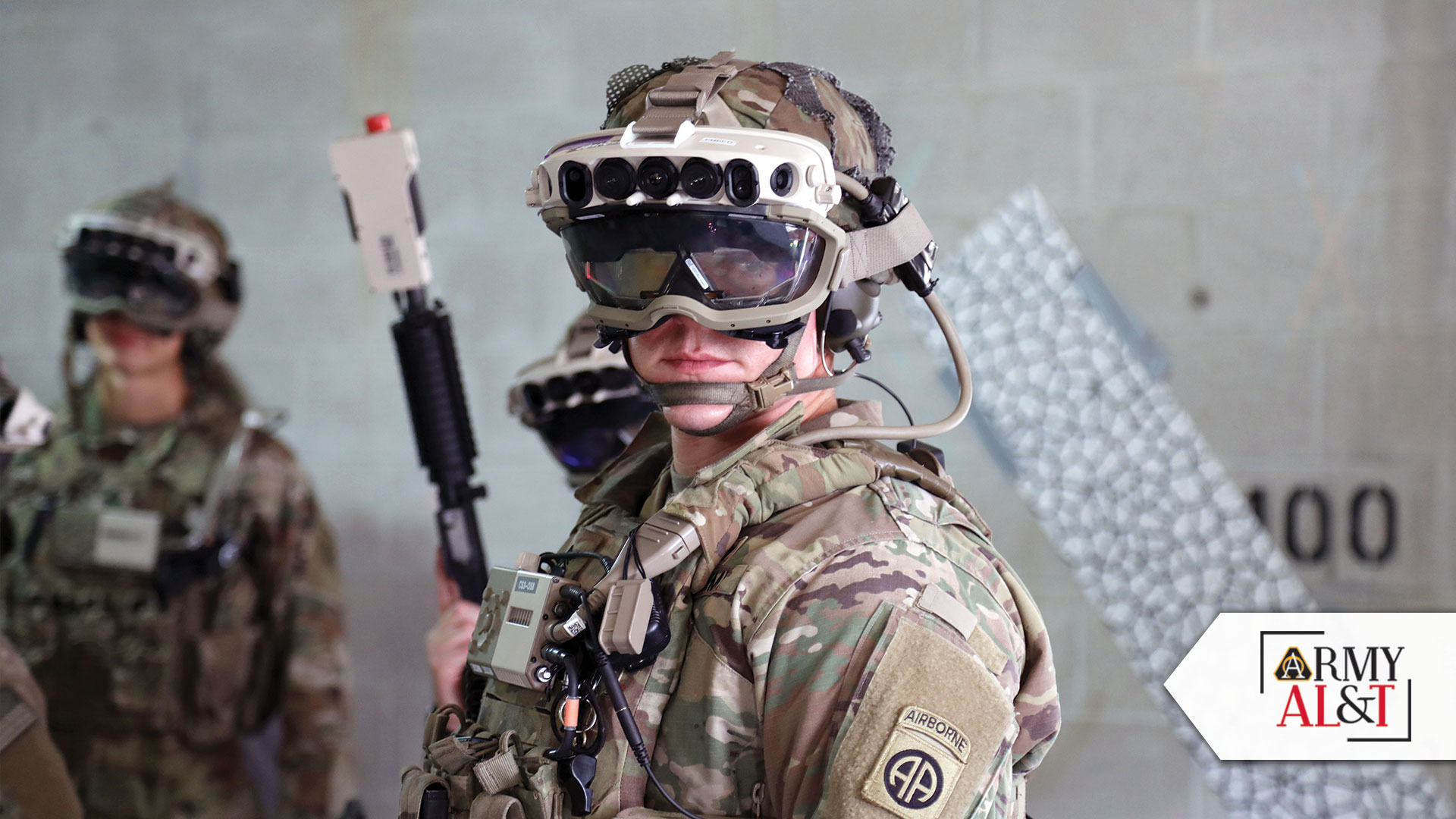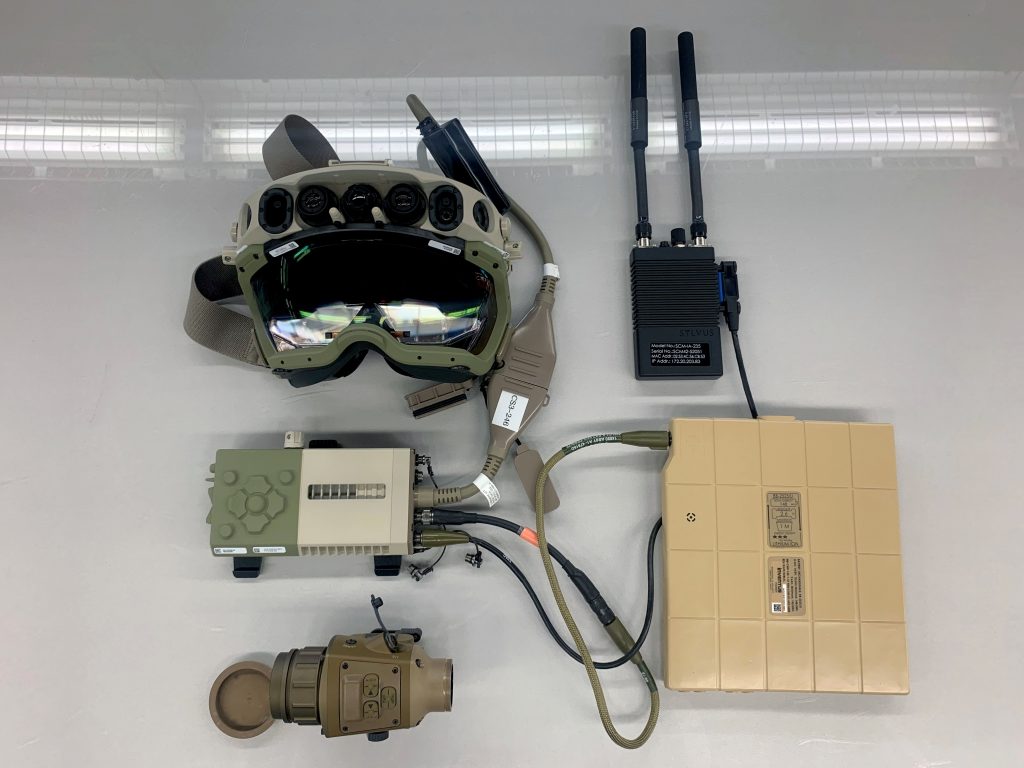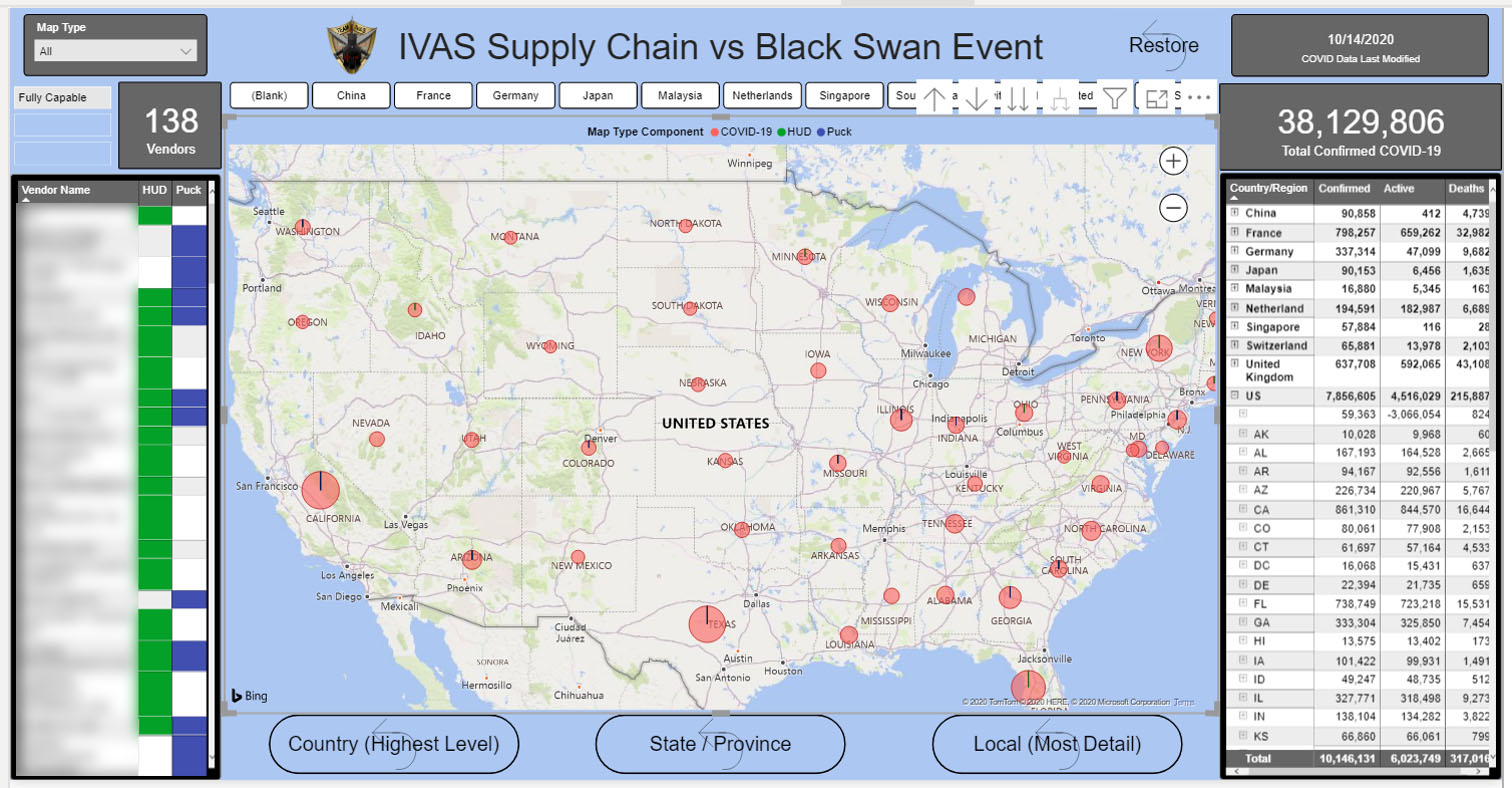
FEEDBACK IS KEY: A Soldier wears the IVAS and wields a Squad Immersive Virtual Trainer prototype at a touch-point event. If not for constant Soldier feedback from these events, the IVAS team would have had a more difficult time adapting the program to COVID-19 restrictions. (Photo by Courtney Bacon, PEO Soldier)
How PEO Soldier has kept IVAS on track as COVID-19 crisis alters plans, procedures.
by Courtney E. Bacon
The COVID-19 pandemic has presented the military and its industrial partners with unique challenges that have forced top modernization efforts to shift standard operating procedures and project timelines.
However, the Army’s Project Manager (PM) for the Integrated Visual Augmentation System (IVAS), in the Program Executive Office (PEO) for Soldier, has worked to minimize COVID-19’s negative impact to the project and the warfighter. To do this, the IVAS team leveraged distributed-work solutions already in routine use, modular hardware design, a core Soldier-centered design philosophy and an intentional supply chain risk-management strategy to support force readiness despite the additional challenges presented by the pandemic.
IVAS is a low-profile, ruggedized heads-up display integrated into the Soldier’s helmet. The goggle hardware is supported by a wearable computer pack, conformal battery, integrated sensors and a squad radio. Collectively, the system provides the close combat force a single platform to fight, rehearse and train. The concerted hardware and a host of services together enable the platform to serve as a combat multiplier.
NOT JUST GOGGLES
When most think of IVAS, the goggle and Soldier-borne hardware package are what comes to mind. However, the complete IVAS suite of capabilities multiplies its warfighting potential beyond just the wearable system. For example, the Squad Immersive Virtual Trainer uses tactical mixed reality in a portable synthetic training environment to enable unlimited iterative training in any domain.

HEADS UP: The Capability Set 3 militarized IVAS prototype. (Photo by Courtney Bacon, PEO Soldier)
“Senior defense officials recognized the erosion in close-combat capabilities and saw an immediate need to ensure overmatch for our dismounted force,” said Mark Stephens, PM IVAS director of acquisition and operations. “Congress recognized the requirement and reprogrammed funds to start IVAS in FY19. Within six months from the secretary of defense’s approval in late May, ‘Team IVAS’ awarded multiple other-transaction agreements to industry and kicked off IVAS before Christmas 2018.”
From the program’s inception, the IVAS rapid-prototype effort required fast-paced and well-organized work from partners around the country. Therefore, the distributed team had built and relied on a digital infrastructure to manage the mission from any physical location. This postured them for success, as they were able to mitigate impacts to the mission and maintain operations, even with social-distancing protocols, while many other projects were more heavily impacted. Before the pandemic, the iterative testing took place in the form of in-person user studies and juries. However, the developmental sprints soon transitioned to taking place remotely, and the team employed the expertise of IVAS test and technology personnel as well as their experienced equipment trainers to push collective feedback to industry partners at Microsoft.
The new strategy allowed the team to continue exchanging sprint software updates between military and industry partners, test the updates in a safe, distributed environment and provide feedback to manage performance risks without having to wait until large test events to discover issues.
TEST PRIORITIES
“As COVID-19 impacted the organization, the test directorate determined that we could still conduct thorough Army-enabled testing with focus on developing the rapid target acquisition, tactical-assault kit, synthetic training environment and other necessary capabilities while maintaining requisite social distance and implementing COVID-approved decontamination procedures,” said Jared Walega, PM IVAS test director.
“Our dispersed team is extremely capable and is able to download the latest software build and load it onto their heads-up displays to continue to iterate. This process has enabled remote testing of software builds and the ability to provide rapid feedback to Microsoft, [including] live-fire video, data and assessments,” Walega added.
Targeting specific capabilities of IVAS for remote development was possible because of the modular architecture and scalable build approach of the composite IVAS system.

COMPONENTS OF A WHOLE: Hardware components of the third capability set prototype of IVAS include the heads up display, conformal wearable battery and puck, as well as the Family of Weapon Sight – Individual. (Photo by Courtney Bacon, PEO Soldier)
“As the hardware matures, we are able to update different aspects of the current form factor based on the modular ‘plug and play’ infrastructure. What that really means is that, as sensor or camera capabilities improve, we are able to pull the obsolete legacy version and replace it with new tech without having to recreate or re-engineer the rest of the integrated hardware,” explained Master Sgt. Marc Krugh, senior enlisted adviser to the PM IVAS test team.
The intentionally scalable architecture, remote collaboration technology and partnership with Microsoft have supported the sustained testing through the pandemic. While the IVAS team’s partnership with Microsoft looks different during the pandemic, as both organizations prioritize the safety of their equipment and personnel, they continue to work together to deliver for the warfighter.
“Microsoft brings cutting-edge, industry-leading techniques that have enabled us to create, test and implement equipment to increase the lethality and mobility of the Soldier and Marine on the battlefield. We continue to value our partnership and take advantage of our remote collaboration solutions that allow us to push forward on planning, verifying and validating toward our end solution, even with COVID restrictions,” said Krugh.
SOLDIER-CENTERED DESIGN
The continued testing and iterative improvement of specific IVAS capabilities throughout the pandemic has been enabled largely by the Soldier feedback collected at every stage of the project’s development.
“Soldier-centered design was developed in IVAS as a combination of Microsoft’s human-centered design philosophy and tailored Army acquisition best practices,” said Walega. “It focuses on current Soldier and Marine input throughout the entire development process to prevent engineers and developers from building a product that does not meet the priorities of our warfighters.”
To ensure that IVAS will truly maximize Soldier lethality, the intentional collection of Soldier feedback at every design and decision point has been a program priority.
IVAS has hosted three Soldier touch-point events, in March 2019, November 2019 and completed the third and largest during October 2020. The IVAS team plans to host one final test event in the third quarter of the 2021 fiscal year. These events put the most up-to-date hardware and software capability sets in the hands of Soldiers to test performance in relevant tactical environments at each decision point.

STRIKE A POSE: A Soldier dons the Capability Set 3 militarized prototype of the IVAS during a Soldier touch-point live fire test event at Fort Pickett, Virginia, in October 2020. (Photo by Courtney Bacon, PEO Soldier)
BRING DATA
“By the end of this [third Soldier touch-point] event, ‘Team IVAS,’ which includes the CFT [cross-functional team], PEO Soldier, Microsoft, Combat Capabilities Development Command, and a number of labs and directorates within the modernization enterprise, will have collected more than 40,000 hours of Soldier data,” said Brig. Gen. Tony Potts, the program executive officer for Soldier.
Potts added, “If we want to develop systems at the speed of relevance, and systems that our Soldiers want to use, this is the way we have to do it. We have learned so much through Soldier-centered design. Our real desire is to let Soldiers design it, and then our engineers build what they design. It’s about listening to our Soldiers.”
The process puts emphasis on making a product that Soldiers will feel confident using to increase their lethality and maximize their efficiency, both in training and on the battlefield.
According to Walega, “If a Soldier loves and uses IVAS, then we have provided a system that has much greater capability than the current kit.”
The Soldier-centric approach has turned out to be a key asset to the project during the disruption in normal operations. Though large-scale test events such as the third Soldier touch-point event included added COVID-19 mitigation precautions, the internal program schedule was also reorganized so as not to delay the deployment of IVAS to the warfighter.
COVID PRECAUTIONS
Although the Soldier touch-point event looked different, Maj. Sean McIntosh was the PM IVAS teammate tasked with leading the implementation of safety measures so that the team was able to continue the mission safely.
“Setting conditions that allow us to continue work during this time is critical for our program’s success,” said McIntosh. “COVID mitigation has been mandatory for everything we do in and out of the office. The entire workforce remains proactive to keep each other safe and has been diligent in abiding by and enforcing the necessary standards to ensure we remain on schedule.”
The team also preemptively reordered the intensive hardware and software design reviews that were initially going to take place after the third Soldier touch-point event, and used their remote tools and a plethora of Soldier feedback to expedite the hardware design review so that it could take place before the October event. This allowed the formal software design sprint to be completed after the third touch-point, and for both designs to be finalized during Capability Set 4 iterations.
“We wouldn’t have the flexibility that we do, frankly, if we hadn’t been doing Soldier touch-points, user juries, user studies and human factors engineering excursions throughout the entirety of the program,” said Col. Christopher Schneider, IVAS project manager.

SCALABLE DATA: IVAS Supply Chain dashboard “local” view that is geographically set at latitude, longitude and zip code. Red bubbles represent COVID-19 data. The blue and green points are color-coded based on IVAS component type. The report may be scaled for greater precision of the information conveyed, such as detailed vendor data. (Image courtesy of PEO Soldier)
SUPPLY-CHAIN RISK MANAGEMENT
Soldier feedback is a contributing factor that has enabled the IVAS project to move forward despite challenges imposed by the coronavirus pandemic. The team’s innovative supply chain risk management strategy and foresight have also significantly contributed to mitigating challenges that have stalled many others.
“With the advent of the coronavirus, the supply chain risk-management strategy has taken on a new level of importance,” said Nicholas Pate, PM IVAS manufacturing engineer. (See related article, “The Visible Supply Chain,” Army AL&T, Fall 2020 Page 45.)
“IVAS vendors have worked tirelessly to assess, analyze and make quick decisions to avert imminent delays. Luckily, the PM IVAS supply chain strategy, from the very start of the program, has always been to mitigate risk by avoiding sole sources of supply, cultivating multiple sensor vendors and ensuring parallel paths of supply,” said Pate.
Though the pandemic has impacted supply chains across industries, the IVAS team has refined its original supply-chain management strategies using flexible vendors that have reacted quickly to minimize negative impacts from COVID-19.
“Microsoft, as well as the low-light and thermal-sensor vendors, delivered preliminary supply chain information on critical components for early risk-mitigation assessment on the IVAS supply chain,” Pate said. “This information ensures that quality and security controls are implemented to ensure a stable and sustainable supply chain.”
The supply chain information collected from vendors was overlaid with health data on COVID-positive “hot spots” to form a dashboard heat map display so that leadership could make critical acquisition and fielding decisions with the most up-to-date data.
“A comprehensive supply chain visibility solution gives program managers the ability to better forecast production and delivery schedules, prioritize risk, and implement alternate sources of supply or contingency plans to ensure equipment can be fielded as planned,” said Stephens. “For fielded systems, [supply chain visibility] will provide unit commanders the ability to better estimate the material availability and readiness for mission tasking and training exercises.”
“It certainly has for us,” Stephens added.

HOT SPOT OVERVIEW: IVAS Supply Chain dashboard scaled for country and state view. Vendor supply chain information was overlaid with health data on COVID-19 hot spots to form a dashboard heat map so that leaders could make critical decisions with the most up-to-date data. (Image courtesy of PEO Soldier)
CONCLUSION
As the IVAS team continues to overcome the obstacles posed by COVID-19, leadership is unwavering in its dedication to the safety of Soldiers and the team.
The third Soldier touch-point event successfully took place at Fort Pickett, Virginia, in October, with proper and thorough COVID-19 mitigation strategies at every step.
The project continues its modernization efforts in service to the Soldier thanks to the team’s remote collaboration technology, scalable architecture, core Soldier-centered design philosophy, supply chain risk-management approach and valuable partnerships within industry.
“I can absolutely say that today we are on track to meet a fourth quarter ‘21 delivery for our first unit equipped,” said Schneider.
For more information, contact PM IVAS Public Affairs Officer Courtney Bacon at courtney.e.bacon.ctr@mail.mil, or visit the PEO Soldier website at https://www.peosoldier.army.mil/.
COURTNEY E. BACON is a public affairs specialist providing PEO Soldier PM IVAS contract support on behalf of TMGL LLC. She has a B.S. in biology from George Mason University and is working toward a master’s degree in biodefense and international security from George Mason’s Schar School of Policy and Government. She previously worked in communications and public affairs for the Defense Information Systems Agency.
Read the full article in the Winter 2021 issue of Army AL&T magazine.
Subscribe to Army AL&T News – the premier online news source for the Army Acquisition Workforce. ![]() Subscribe
Subscribe







